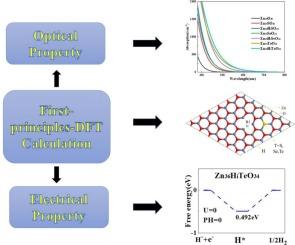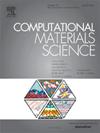点缺陷和等效元素掺杂对ZnO单层膜光电催化性能影响的理论计算研究(0 0 1)
IF 3.3
3区 材料科学
Q2 MATERIALS SCIENCE, MULTIDISCIPLINARY
引用次数: 0
摘要
在真空条件下,通过常压等离子体制备ZnO体系往往会不可避免地导致外在H间隙的存在。以往的研究忽略了氧空位和氢间隙的共存,物理实验中对点缺陷的处理具有挑战性。本研究利用第一性原理GGA + U方法系统分析了氧空位和氢间隙共存对光催化性能的影响。研究重点是两个系列(0 0 1)取向单层:Zn36TO34和Zn36HiTO34,其中T代表硫元素(S, Se, Te)。在所有系统中,Zn36HiTeO3(0 0 1)单层表现出最佳性能。该材料在富锌条件下稳定性增强,具有良好的生成能和较高的催化活性。其优越的特性包括扩展的光吸收范围,适当的工作功能,延长的载流子寿命,以及卓越的光催化还原能力。值得注意的是,Zn36HiTeO3(0 0 1)体系具有双重功能优势:相对较低的内部电压和优异的电催化性能。这些发现为设计先进的zno基材料在光催化和电催化中的应用奠定了基本的理论原则。本文章由计算机程序翻译,如有差异,请以英文原文为准。

Theoretical computational study of the effect of point defects and equivalent elemental doping on the photoelectrocatalytic properties of ZnO monolayers (0 0 1)
Under vacuum conditions, the preparation of ZnO systems via atmospheric pressure plasma often results in the inevitable presence of extrinsic H interstitials. Previous studies have neglected the coexistence of oxygen vacancies and H interstitials, and the manipulation of point defects in physical experiments is challenging. This study utilizes the first-principles GGA + U approach to systematically analyze how the co-existence of oxygen vacancies and hydrogen interstitials affects photocatalytic properties. The investigation focuses on two series of (0 0 1)-oriented monolayers: Zn36TO34 and Zn36HiTO34, where T represents chalcogen elements (S, Se, Te). Among all systems, the Zn36HiTeO3 (0 0 1) monolayer demonstrates optimal performance. This material exhibits enhanced stability under zinc-rich conditions, along with favorable formation energy and high catalytic activity. Its superior characteristics include extended light absorption range, appropriate work function, prolonged carrier lifetime, and exceptional photocatalytic reduction capacity. Notably, the Zn36HiTeO3 (0 0 1) system displays dual functional advantages: relatively low internal voltage and excellent electrocatalytic performance. These findings establish fundamental theoretical principles for designing advanced ZnO-based materials in both photocatalytic and electrocatalytic applications.
求助全文
通过发布文献求助,成功后即可免费获取论文全文。
去求助
来源期刊

Computational Materials Science
工程技术-材料科学:综合
CiteScore
6.50
自引率
6.10%
发文量
665
审稿时长
26 days
期刊介绍:
The goal of Computational Materials Science is to report on results that provide new or unique insights into, or significantly expand our understanding of, the properties of materials or phenomena associated with their design, synthesis, processing, characterization, and utilization. To be relevant to the journal, the results should be applied or applicable to specific material systems that are discussed within the submission.
 求助内容:
求助内容: 应助结果提醒方式:
应助结果提醒方式:


